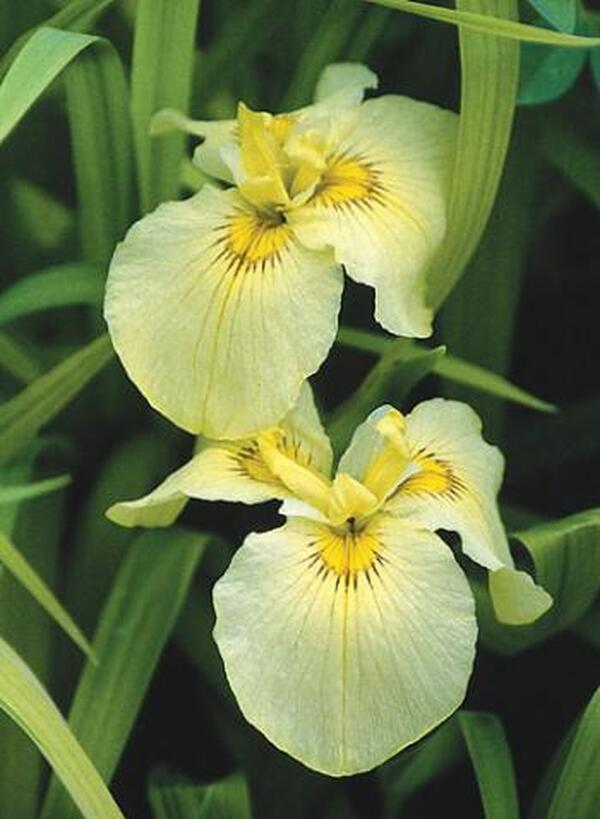Iris x pseudata 'Aichi no Kagayaki'
Aching Tongue Iris
This plant is not currently for sale. This is an archive page preserved for informational use.
Shop Available IrisItem #: 5794
Zones: 5a to 9b
Dormancy:
Height: 36" tall
Origin: Hybrid
Pot Size: 3.5" pot (24 fl. oz/0.7 L)
Despite the tongue-twisting name, which means "bright inspiration," we really enjoy this bizarre cross of Iris pseudacorus x Iris ensata. While it grows well in shallow water, we grow ours in dry sand where it is equally wonderful. The deer-resistant foliage emerges chartreuse-yellow in spring, highlighted by the large flowers in mid-May (NC). Each hummingbird-attracting flower is light yellow, topped by an attractive brown marking near the base of the petals. As compared to the prolific-seeding Iris pseudacorus, the best feature of Iris 'Aichi no Kagayaki' (my #@x@x* spell checker keeps insisting on Kawasaki) is its sterility...no garden abortions necessary.
Maintenance:
Iris x pseudata cultivars are deciduous and the foliage is not ornamental once browned by a hard frost so the foliage can be cut to the ground at this point. As the pseudata hybrids are sterile it is not necessary to remove spent flowers after their bloom season is over to prevent seeding, but the tidy gardener might want to dead head them to improve their appearance. Either cut the spent flower stalks down to the foliage, or remove the whole fan that bloomed, cutting it to the ground. Leave all of the fans that have not bloomed. The foliage remains attractive for the rest of the summer so normally needs no more maintenance until the final cut down after frost. The pseudata hybrids are clump formers, not runners, so might only need reigning in after many years of growth, if even then. These iris are only propagated by division and can be divided most any time of the year.
Growing Conditions:
The pseudata hybrids are sun lovers as are both of their parents. They will perform satisfactorily in average moisture soil but really thrive in damp soil including heavy wet clays. They can be a great addition to areas too wet for many other plants. Wet areas should be celebrated as they afford the gardener the chance to grow moisture loving plants which do not thrive in the average garden. These iris are also suited to the varied moisture levels of a rain garden.
Garden Value:
Iris x pseudata cultivars are very showy in bloom, rivaling the display of any other type of iris. As they are sterile, that is, they produced no seed, they will never present any risk of becoming a weed. This is in contrast to one of their parents, the European Yellow Water Iris, Iris pseudacorus, which is a serious invasive exotic in the U.S. where it often dominates native wetland areas.
The Iris x pseudata hybrids are of fairly recent introduction. Hybridizing their two parents, the Japanese Iris (Iris ensata) and the European Yellow Water Iris (Iris pseudacorus) was thought to be impossible. The current cultivars are all of the most elegant simple form. Ones that associate comfortably with other garden flowers. Acquire them now when they are available because it is certain that breeders are actively working to create ruffled and doubled and overly large monstrosities.
The foliage of some Iris x pseudata cultivars is bright yellow in new growth. This is a highly beautiful ornamental feature, adding color for months before the floral display.
Natural Impact:
Iris tend to be ignored by deer. It is likely that their dense clumps of foliage could provide over-wintering habitat for small creatures if the gardener is willing to leave the foliage until spring.
-
Other Attributes
Genus: Iris
Flower Color: Yellow/Gold
Leaf Color: Green , Variegated , Yellow/Gold
Bloom Time: Spring
Container Role: Fillers , Thrillers
Garden Themes: Cottage Garden Plants
Other: Bog Garden Plants , Butterfly Attracting Plants , Cut Flower Plants , Deer Resistant Plants , Hummingbird Plants , Pollinator Plants , Plants that Attract Birds , Rabbit Resistant Plants , Rain Garden Plants , Colored Foliage , Patterned Foliage


